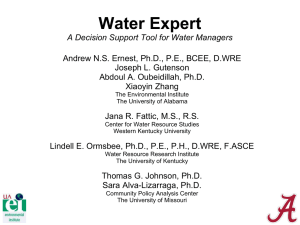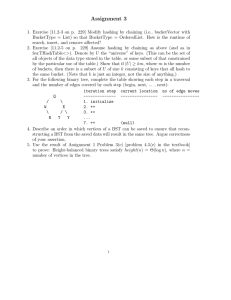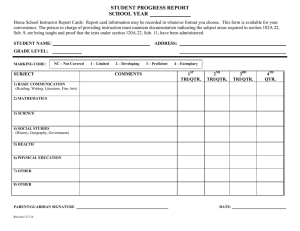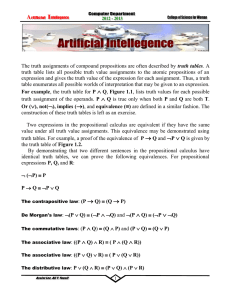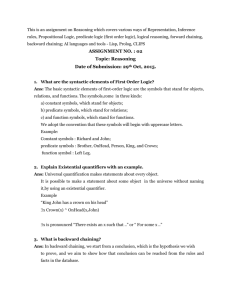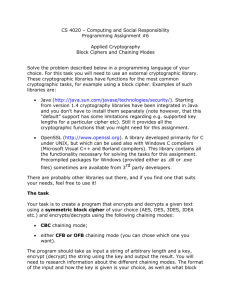A NEW METAPHOR FOR THE ... FORWARD-CHAINING RULE EXECUTION John Domingue & Marc Eisenstadt
advertisement
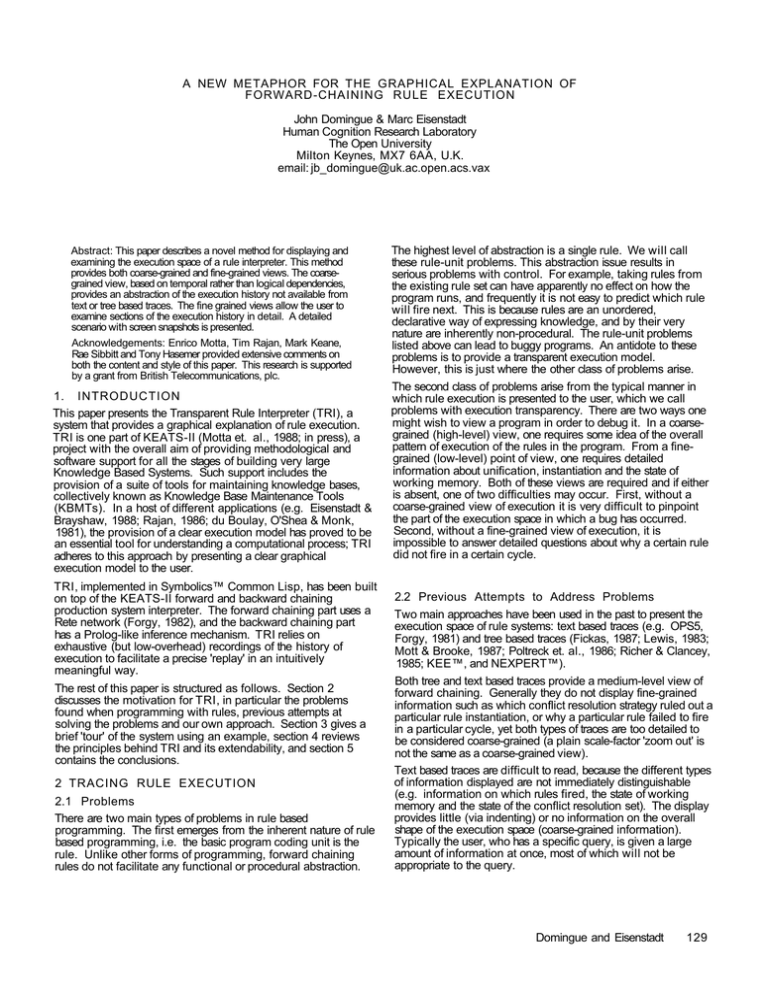
A NEW METAPHOR FOR THE GRAPHICAL EXPLANATION OF
FORWARD-CHAINING RULE EXECUTION
John Domingue & Marc Eisenstadt
Human Cognition Research Laboratory
The Open University
Milton Keynes, MX7 6AA, U.K.
email: jb_domingue@uk.ac.open.acs.vax
Abstract: This paper describes a novel method for displaying and
examining the execution space of a rule interpreter. This method
provides both coarse-grained and fine-grained views. The coarsegrained view, based on temporal rather than logical dependencies,
provides an abstraction of the execution history not available from
text or tree based traces. The fine grained views allow the user to
examine sections of the execution history in detail. A detailed
scenario with screen snapshots is presented.
Acknowledgements: Enrico Motta, Tim Rajan, Mark Keane,
Rae Sibbitt and Tony Hasemer provided extensive comments on
both the content and style of this paper. This research is supported
by a grant from British Telecommunications, plc.
1. INTRODUCTION
This paper presents the Transparent Rule Interpreter (TRI), a
system that provides a graphical explanation of rule execution.
TRI is one part of KEATS-II (Motta et. al., 1988; in press), a
project with the overall aim of providing methodological and
software support for all the stages of building very large
Knowledge Based Systems. Such support includes the
provision of a suite of tools for maintaining knowledge bases,
collectively known as Knowledge Base Maintenance Tools
(KBMTs). In a host of different applications (e.g. Eisenstadt &
Brayshaw, 1988; Rajan, 1986; du Boulay, O'Shea & Monk,
1981), the provision of a clear execution model has proved to be
an essential tool for understanding a computational process; TRI
adheres to this approach by presenting a clear graphical
execution model to the user.
TRI, implemented in Symbolics™ Common Lisp, has been built
on top of the KEATS-II forward and backward chaining
production system interpreter. The forward chaining part uses a
Rete network (Forgy, 1982), and the backward chaining part
has a Prolog-like inference mechanism. TRI relies on
exhaustive (but low-overhead) recordings of the history of
execution to facilitate a precise 'replay' in an intuitively
meaningful way.
The rest of this paper is structured as follows. Section 2
discusses the motivation for TRI, in particular the problems
found when programming with rules, previous attempts at
solving the problems and our own approach. Section 3 gives a
brief 'tour' of the system using an example, section 4 reviews
the principles behind TRI and its extendability, and section 5
contains the conclusions.
2 TRACING RULE EXECUTION
2.1 Problems
There are two main types of problems in rule based
programming. The first emerges from the inherent nature of rule
based programming, i.e. the basic program coding unit is the
rule. Unlike other forms of programming, forward chaining
rules do not facilitate any functional or procedural abstraction.
The highest level of abstraction is a single rule. We will call
these rule-unit problems. This abstraction issue results in
serious problems with control. For example, taking rules from
the existing rule set can have apparently no effect on how the
program runs, and frequently it is not easy to predict which rule
will fire next. This is because rules are an unordered,
declarative way of expressing knowledge, and by their very
nature are inherently non-procedural. The rule-unit problems
listed above can lead to buggy programs. An antidote to these
problems is to provide a transparent execution model.
However, this is just where the other class of problems arise.
The second class of problems arise from the typical manner in
which rule execution is presented to the user, which we call
problems with execution transparency. There are two ways one
might wish to view a program in order to debug it. In a coarsegrained (high-level) view, one requires some idea of the overall
pattern of execution of the rules in the program. From a finegrained (low-level) point of view, one requires detailed
information about unification, instantiation and the state of
working memory. Both of these views are required and if either
is absent, one of two difficulties may occur. First, without a
coarse-grained view of execution it is very difficult to pinpoint
the part of the execution space in which a bug has occurred.
Second, without a fine-grained view of execution, it is
impossible to answer detailed questions about why a certain rule
did not fire in a certain cycle.
2.2 Previous Attempts to Address Problems
Two main approaches have been used in the past to present the
execution space of rule systems: text based traces (e.g. OPS5,
Forgy, 1981) and tree based traces (Fickas, 1987; Lewis, 1983;
Mott & Brooke, 1987; Poltreck et. al., 1986; Richer & Clancey,
1985; KEE™, and NEXPERT™).
Both tree and text based traces provide a medium-level view of
forward chaining. Generally they do not display fine-grained
information such as which conflict resolution strategy ruled out a
particular rule instantiation, or why a particular rule failed to fire
in a particular cycle, yet both types of traces are too detailed to
be considered coarse-grained (a plain scale-factor 'zoom out' is
not the same as a coarse-grained view).
Text based traces are difficult to read, because the different types
of information displayed are not immediately distinguishable
(e.g. information on which rules fired, the state of working
memory and the state of the conflict resolution set). The display
provides little (via indenting) or no information on the overall
shape of the execution space (coarse-grained information).
Typically the user, who has a specific query, is given a large
amount of information at once, most of which will not be
appropriate to the query.
Domingue and Eisenstadt
129
Although tree-based traces are suitable for backward chaining,
we believe that they are not appropriate for displaying the
execution of forward chaining because the dependencies among
forward chaining rules are frequently temporal as well as (or
indeed instead of) logical. For example, ruleA may fire and add
many things to working memory, one of which causes rule B to
fire immediately, but it can be very awkward to consider ruleA a
logical 'precursor' or 'subgoal' of ruleB (and therefore display it
with a special link from ruleA to ruleB), precisely because of the
'spreading' effects of all of the other rules which ruleA may
have triggered. It is in the realm of this 'spreading' effect that
the limitations of graphical forward-chaining rule tracers such as
the ones used by KEE and NEXPERT™ become apparent.
We therefore opt for a metaphor which is not tree-oriented, as
described next.
2.3 T h e T R I A p p r o a c h
Our solution to representing the coarse-grained behaviour of a
forward-chaining rule interpreter is to have an explicit
representation of the time dimension, based on a 'musical score'
metaphor (cf. VideoWorks™, 1985). Each rule is analogous to
a particular musical instrument, and the the individual execution
cycles of the rule interpreter correspond to 'beats' or 'measures'.
A simple example is shown in figure 1.
Given the style of display shown in figure 1, we can then
provide facilities for the user to 'replay' execution, or to focus
on particular moments of time and then to examine the finegrained view to answer particular questions.
Figure 1. A graph showing the execution of the rules ruleA, ruleB and
ruleC over five cycles. The + means that a rule fired, a box means that a
rule entered the conflict resolution set but did not fire. The rules fired in the
order: ruleB, ruleC, ruleA, ruleB, ruleC. RuleA entered the conflict
resolution set during the first 3 cycles only.
The issue of what to display at a fine-grained level is much
simpler (e.g. variable bindings, working memory contents),
and in many ways has been addressed already by generations of
textual-based tracers for production systems such as OPS 5.
However, TRI provides two novel extensions to earlier (textualbased) fine-grained displays:
•
high selectivity: the user can select elements for fine-grained
viewing in a range of ways, depending upon the time, the
rule, the working memory pattern, or any combination;
•
synchronization with coarse-grained view; both views can
be presented simultaneously, so that as the coarse-grained
view is manipulated (e.g. 'played forward'), the finegrained view changes appropriately.
3 SCENARIO
3.1 The Rulebase and Desktop
Suppose that a TRI user has loaded a rulebase based on Poltreck
et. al. (1986), which finds all the routes between two cities.
The rules, shown in figure 2, are forward-chaining, with the
exception of bl and b2, which are backward-chaining.
The rules were run w i t h i n i t i a l w o r k i n g m e m o r y ' ( ( o r i g i n
austin)
( d e s t i n a t i o n d a l l a s ) ) p r o d u c i ng the output:
Highway 3 5 : A u s t i n - > 6 0 - > Temple - > 3 4 - > Waco - >
4 1 - > H i l l s b o r o - > 4 8 - > D a l l a s { M i l e a g e : 183}
Highway 1 0 : A u s t i n - > 1 0 - > S a n - A n t o n i o - > 2 0 - >
F r e d r i c k s b u r g - > 5 0 - > D a l l a s { M i l e a g e : 80}
130
Tools
fact-1:
if
than
( h i g h w a y 35
( ( s a n - a n t o n i o a u s t i n 74) ( a u s t i n t e m p l e
( t e m p l e waco 34) (waco h i l l s b o r o 41)
( h i l l s b o r o dallas 48)))
fact-2:
if
then
( h i g h w a y 10
( ( a u s t i n s a n - a n t o n i o 10)
( s a n - a n t o n i o f r e d e r i c k s b u r g 20)
(fredericksburg dallas 50)))
b l <backward>: ( a d j c i t i e s ? h ? c l ?c2 ?d) i f
(highway ?h ? l i s t )
( : l i s p (member-of (?c2 ? c l ?d) ? l i s t ) )
b 2 <backward>:
( a d j e i t i e s ? h ? c l ?c2 ?d) i f
(highway ?h ? l i s t )
( : l i s p (member-of ( ? c l ?c2 ?d) ? l i s t ) )
start: if (origin ?start)
( d e s t i n a t i o n ?end)
(highway ?h ? l i s t )
t h e n ( f i n d - r o u t e ? s t a r t ?end ( ) ? h 0 )
add-clty-to-route:
60)
i f ( f i n d - r o u t e ? s t a r t ?end ? p a t h ? r o a d ?n)
t h e n ( : l i s p ( e s t a b l i s h ( ( a d j e i t i e s ?road ? s t a r t
? n e x t ?new d i s t a n c e ) ) : a l l t ) )
;;;the above e s t a b l i s h invokes backward-chainer (& finds all sol'ns)
route-simple:
i f ( a d j e i t i e s ?road ? s t a r t ?next ?new-distance)
t h e n ( r o u t e ? s t a r t ?next ?road ?new-distance)
add-city-to-route2:
i f ( f i n d - r o u t e ? s t a r t ?end ? p a t h ? r o a d ?n)
( r o u t e ? s t a r t ?next ?road ?new-distance)
?any-total)
then
? p a t h : - ( a p p e nd ? p a t h ( ? s t a r t ? n e w - d i s t a n c e ) )
? t o t a l :- (+ ?n ?new-distance)
( r o u t e ? s t a r t ?next ?road ? t o t a l )
( f i n d - r o u t e ? n e x t ?end ? p a t h ? r o a d ? t o t a l )
end: i f ( f i n d - r o u t e ? x ? x ? p a t h ? r o a d ?n)
( d e s t i n a t i o n ?x)
then <print route>
Figure 2 The Rulebase taken from Poltreck et. al., 1986. The first iwo
rules simply add assertions about the distances between some cities in Texas
on Highway Number 35 and Highway Number 10, respectively.
The user then examines the execution history and after a few
operations, the T R I 'desktop' is in the state shown in figure 3.
For clarity of exposition, figure 3 is only a schematic showing in
outline form the contents of 8 separate windows. Only window
1 is displayed initially, with the rest being generated on demand
to satisfy specific user requests. Details of specific windows are
described in turn below.
Figure 4. Close-­up of the rule graph frame (window 1 in figure 3).
3.2 P r o v i d i n g a Coarse-­Grained View of the
Execution
The coarse-­grained view is provided by window 1 (the rule
graph frame) in the top left of figure 3. As well as an abstract
view the rule graph frame provides two other facilities:
•
the ability to focus on various a slices of the execution space
in detail,
•
the ability to replay the execution.
3.3 Fine Graine d Views of the Execution
TRI allows the user to view slices of the execution in detail. The
full contents of working memory at any particular cycle can be
shown in a separate window. For example, the state of working
memory at cycle 24 in the current example is shown in figure 5
{not part of the user's desktop in figure 3). This view window
can be tailored to show the rules, predicates, or firing
instantiation for a chosen execution cycle. Indeed, any number
of tailored variants of the window can be disnlaved at once.
The actual appearance of window 1 is shown in figure 4.
The largest pane in the rule graph frame shows a graph of the
execution history, which we call the rule graph. The rule graph
enables the user to view around fifty rules for fifty cycles at a
glance (this could trivially be increased to one hundred cycles by
decreasing the inter-­cycle gap). Horizontal and vertical scrolling
extend the practical limits to hundreds of rules and hundreds of
cycles. T R I allows the user to collapse any set of rules into a
single row, allowing robust forward chaining rules to be 'black
boxed away. Each row represents the execution space of one
or more rules with each of the symbols indicating a particular
type of event happening to one instantiation. Each set of rules
contains a corresponding set of instantiations (the set of
instantiations created from working memory and the set of
rules). The symbols denote the following:
A -­ one of the instantiations in the set fired and backward
chaining occurred,
+ -­ one of the instantiations in the set fired, and
L..i -­ at least one instantiation entered the conflict resolution set
and none of the instantiations in the set fired,
Where there is no symbol, all of the rules in the set failed to
match against working memory and no instantiations were
created.
Figure 5. Contents of working memory (in cycle order) at cycle 24.
A more specialized slice of working memory is chosen by
selecting some predicates from a menu and then selecting the
current cycle by clicking on one of the numbers in the rule
graph. The predicate of a working memory pattern is the first
part of the pattern, sofoo is the predicate of the working
memory pattern ffoo x y z ] . Windows 2, 3, and 4 (called
predicate windows) at the right of figure 3 show three slices of
working memory for the three predicates adjeities, find-route
and route. Each predicate window shows all the working
memory patterns present at the current cycle, for the predicate.
Figure 6 shows the actual appearance of window 2 in detail.
The rule graph presents a picture of the overall 'shape' of the
execution; we can see clumps consisting of a A followed by
two + son the line immediately above and we can also see two
diagonal lines consisting of + A++
A regular user of TRI
would recognise these patterns as cliches in the program and
would be able to notice missing 'friendly' cliches and spot
unwanted 'unfriendly' cliches. The rule route-simple fires
immediately after the rule add-city-to-route, sometimes firing
once and sometimes firing several times in succession. The rule
add-city-to-route2 always fires immediately after the rule routesimple has fired one or more times. The rule fact-1 which
deposits facts about highway 35, fires first, the rule fact-2 which
deposits facts about highway 10 does not fire until after the rule
end, which prints a route, has fired. The rule start fires only
twice, each time immediately after one of the fact rules have
fired. We see that the rule graph provides answers to coarse-­
grained questions such as "When is a rule is likely to fire?",
"Which rules fire together?". This sort of information is not
readily available from text or tree based traces.
Figure 6. The a d j e i t i e s predicate window (window 2 in figure 3).
The predicate has been omitted from each of the displayed
working memory patterns as it is redundant (it is displayed as
the title of the predicate window). The number before each of
the patterns is the cycle during which the pattern was deposited
in working memory. Each pattern is mouse sensitive, enabling
either the relevant node in the rule graph to be highlighted, or a
more detailed description of the pattern to be displayed.
Domingue and Eisenstadt
131
A slice of the conflict resolution set is chosen by clicking on one
of the nodes in the rule graph. Windows 7 and 8 at the bottom
left of the figure show two slices of the conflict resolution set.
Figure 7 shows the actual appearance of window 8.
Figure 7. Close-­up of node examination frame for rule r o u t e -­ s i m p l e
(window 8 in figure 3). Winning instantiation is shown in italics.
Figure 8. Close-­up of node examination frame for rule add-­city-­to-­route
(window 7 in figure 3). Winning instantiation is shown in italics, and
backward-­chaining call is shown in bold italics. The rectangle surrounding
the bold italic region indicates that it has just been selected by the mouse,
yielding further detail as shown in figure 9.
Each frame (called a node examination frame) has two
components. The top part of the frame contains the definition of
the rule; the bottom part shows all the instantiations the rule had
in the conflict set. This allows easy comparison of the
instantiated rule with the source code. The bottom left frame
was created by clicking on the + node in cycle 24 in the rule
graph; it contains all the instantiations in the conflict resolution
set at cycle 24 for the rule route-simple. The top instantiation is
in italics indicating that this instantiation fired in cycle 24. Each
instantiation is mouse sensitive, allowing operations such as
displaying or editing the deleting conflict resolution strategy.
The second node examination frame (window 7), shown in
detail in figure 8, was created by clicking on the triangle under
the number 23 in the rule graph.
We can see that the top (firing) instantiation is in italics. We can
also see that the first (and only) clause in the consequent of the
instantiation is in bold. The holding indicates that, when the rule
fired, backward chaining occurred. Clicking on this clause
displays the proof tree, shown by the bottom right frame in
figure 3, and in detail in figure 9.
The tree represents the execution history of backward chaining
rules. Each node in the tree corresponds to a goal, which may
or may not have been successful, within the execution. The
display of proof trees is based on the Transparent Prolog
Machine (Eisenstadt & Brayshaw, 1988): a white node indicates
a success; a black node indicates a failure; grey indicates
'succeeded earlier but failed on backtracking'; circles indicate
calls to primitives or Lisp functions. It is possible to abstract the
tree both by zooming out (it is possible to zoom in again, as has
been done in figure 9) and by collapsing a predicate. When a
predicate is collapsed the subtree of the predicate is not shown,
allowing robust backward chaining rules to be 'black boxed'
away, facilitating the display of thousands of nodes in a large
proof tree.
132
Tools
Figure 9. Close-­up of backward-­chaining proof tree for a d j c i t e s
(window 5 in figure 3). This snapshot is taken in the middle of 'replay'.
Each node in the tree is mouse sensitive. Clicking on a node
displays more detailed information (as can be seen in window 6
above the proof tree in figure 3) including: the rule the goal was
called from; the source code version of the call; and the actual
call, in which variables are likely to have been renamed. A
screen snapshot of window 6 is reproduced below as figure 10.
4.2 Scaling up to large programs
The acid test of a tracing/monitoring environment is its
performance on real programs. TRI is used daily on the
KEATS-­II project, and its very conception and design is meant
to facilitate the handling of very large programs. Some recent
runs of TRI in KEATS-­II (which mostly uses frames rather than
rules) yielded the following statistics:
Number of rules: 100
Number of working memory elements: 93
Number of competing rule instantiations on a given cycle: 108
Number of forward-­chaining cycles: 150
Number of backward-­chaining 'history' steps: 4388
Number of nodes in backward-­chaining proof tree: 199
Figure 10. Close-­up of detailed expansion of backward-­chaining tree node,
showing variable bindings (window 6 in figure 3).
3.4 Replaying the Execution
The large number of backward-­chaining 'history' steps is due to
the detailed record of backtracking which is kept by TRI, where
a 'step' corresponds to a 'call', 'exit', 'fail' or 'redo' operation
analogous to those of Prolog.
The following features enable TRI to scale up to large problems:
Clear conceptual distinction between coarse-grained and
fine-grained views: the abstractions provided are genuinely
different, not just those obtainable via physical 'scale factor'
zooming.
The execution can be replayed using the replay panel (the menu
containing the symbol <= in figure 4). Using the replay panel
the user can choose to single step forwards or backwards, or to
replay the history. As the execution is replayed, each cycle
column in the rule graph is highlighted in turn (like a player
piano roll) and all the currently displayed fine-­grained views are
updated. Each of the fine-­grained views acts as a measuring
device, providing very detailed information on a specific part of
the execution.
4 Assessing T R I
4.1 T e m p o r a l dependencies vs. logical dependencies
The key insight underlying TRI has been the emphasis on
temporal dependencies during forward chaining, providing in
essence a 'musical score' metaphor for the coarse-­grained view.
This contrasts directly with an emphasis on logical
dependencies, the display of which relies typically on a
tree/net/link metaphor. It would be foolish for TRI to ignore
logical dependencies, especially in those cases where they are
highly meaningful to an individual user, or simply more
appropriate in a particular context. Therefore, TRI facilitates the
display of logical dependencies in three ways: (a) the
dependency between any working memory element (as shown in
a specific 'predicate window', for instance) and the rule which
was responsible for depositing that element can be highlighted
by the user with a single mouse-­click on the chosen working
memory element, resulting in a 'blink' of the ''+'' symbol at the
appropriate 'culprit' spot in the rule graph display; (b) a
dependency tree for any working memory element, including
ones deposited during forward chaining, can be displayed upon
request-­ the appearance is that of an AND/OR tree much like the
one we use for backward chaining; (c) the backward chaining
proof tree itself is of course a tree of logical dependencies, made
easy for TRI because of the restriction that backward chaining
rules be expressed (like Prolog) as pure Horn clauses.
Logical dependencies have been de-­emphasised in this paper,
because AND/OR trees are not new. Clearly, the individual user
needs to have the freedom to choose the right abstraction for the
right purpose, and that is precisely the mixture that TRI was
designed to provide.
•
Chunking of rules into sets: entire rule sets may be
'expanded' and 'collapsed' in the left-­hand column of the
rule graph display, analogous to the operations of a
hierarchical file directory browser. Chunking can be
provided automatically, according to rules which co-­exist in
separate 'rule contexts', or manually, at the user's
discretion. This allows the aggregate behaviour of many
hundreds of rules to be seen at a glance.
•
Collapsing of details into one node: in the backward-­
chaining proof trees, entire sub-­trees which are either un-­
interesting or too space-­consuming can be collapsed into a
single node, which itself may be expanded and explored in
a separate window. This enables trees with thousands of
nodes and tens of thousands of execution steps to explored
in a meaningful way.
Global view: The coarse-­grained view of proof trees can
itself be physically scaled (zoomed) in a separate window
which provides a broader navigational perspective-­ this is
the 'zoom' typical of existing environments, and is
therefore not new to TRI, but is provided for convenience
and completeness.
Peformance overheads of TRI's monitoring facilities are low
(approximately 5% increase in execution time), which seems like
a reasonable price to pay for being able to obtain a thorough
view of execution for complex rule sets. The monitoring
facilities can be disabled at the user's discretion. We are looking
forward to future tests of TRI's power on very large rule bases.
5 CONCLUSIONS AND FUTURE WORK
In this paper we have described TRI, a system that provides a
graphical explanation of both forward and backward chaining.
Our main aim in designing TRI was to overcome the difficulty of
providing an abstract view of the execution with easy access to
low level views. Our hope is that providing the rule based
programmer with these two views will greatly decrease the time
Domingue and Eisenstadt
133
taken to discover the cause of bugs. We have witnessed this
informally in our lab, and are planning a series of empirical
studies to demonstrate the effect in a robust fashion. A further
spinoff, consistent with other ongoing work in our lab (e.g.
Hasemer & Domingue, 1989), is the provision of a transparent
view of the inner workings of a machine ideally suited for
helping to teach rule-­based programming to novices. Toward
this end, we have incorporated the rule graph notation into an
Open University course on Knowledge Engineering (Kahney,
1989).
We are currently extending T R I to provide information on the
performance as well as the behaviour of rule based programs in
a unified display. In particular, iconic metering tools are being
provided for both forward and backward chaining. KEATS-­II
has a truth maintenance system, and TRI is being extended to
show dynamically the way in which making an 'in' assertion
'out' (for instance) propagates effects through a network of
dependency links. We eagerly await the results of this new
research.
REFERENCES
du Boulay, B., O'Shca, T. & Monk, J. The Black Box Inside the Glass
Box: Presenting Computing Concepts to Novices. International
Journal of Man-Machine Studies. Vol. 14, pp. 237-­249,1981.
Eisenstadt, M. & Brayshaw, M. The Transparent Prolog Machine (TPM):
an execution model and graphical debugger for logic programming.
Journal of Logic Programming, Vol. 5, No. 4, 1988, pp. 1-­66.
Fickas, S. Supporting the Programmer of a Rule Based Language. Expert
Systems, Vol. 4, No. 2 pp. 74-­87. May 1987.
Forgy, C. L. Rete: A Fast Algorithm for the Many Pattern/ Many Object
pattern Matching Problem. Artificial Intelligence, 19:17-­37, 1982.
Forgy, C. L. OPS5 User's Manual, July 1981.
Hasemer, T., & Domingue, J. Common Lisp Programming for Artificial
Intelligence. London: Addison-­Wcsley, 1989.
Lewis J. W. An Effective Graphics User Interface for Rules and Inference
Mechanisms. Proceedings of Computer and Human Interaction.
December 1983 pp. 139-­143.
Kahney, H. (Ed.) Knowledge Engineering. (Open University study pack
PD624, Learning materials service office, the Open University), Open
University Press, 1989.
KEE™ and Knowledge Engineering Environment (v 3.1) -­ are registered
trademarks of IntelliCorp Inc.
Mott, P. & Brooke, S. A Graphical Inference Mechanism. Expert
Systems, May 1987. vol. 4. No. 2 pp. 106-­117
Motta, E., Eisenstadt, M., Pitman, K. & West, M. KEATS: Support for
Knowledge Acquisition in The Knowledge Engineer's Assistant
(KEATS). Expert Systems 5 (1), 1988, pp. 6-­28
Motta, E., Rajan, T, & Eisenstadt, M. Knowledge acquisition as a process
of model refinement. International Journal of Man-Machine Studies, in
press.
NEXPERT™ is a registered trademark of Neuron Data Inc.
Poltreck, S.E., Steiner,.D. D., & Tarlton, P. N. Graphic Interfaces for
Knowledge-­Based System Development. Proceedings ACM Conference
on Computer Human Interaction, 1986.
Rajan, T.M. APT: A Principled Design for an Animated View of Program
Execution for Novice Programmers. Technical Report 19. Human
Cognition Research Laboratory. Milton Keynes, MK7 6AA.
December 1986.
Richer, M. & Clancey, W. Guidon-­Watch: A Graphic Interface for
Viewing a Knowledge-­Based System. IEEE Computer Graphics and
Applications. 5, 11, 1985.
Symbolics™ is a registered trademark of Symbolics, Inc.
VideoWorks™ is a registered trademark of MacroMind, Inc. (1985).
134
Tools
